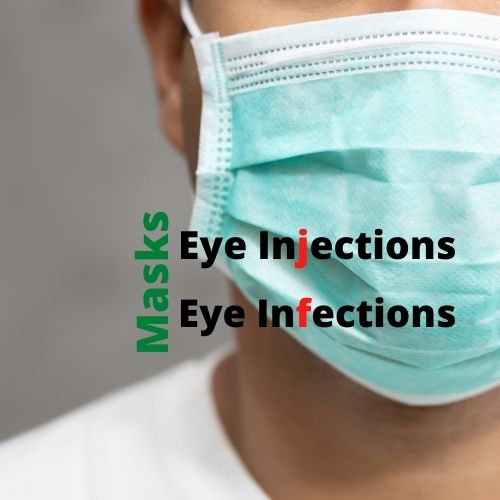Face Mask Needed for Eye Injections


Extra safety measures are recommended for face mask wearers during anti-VEGF injections.
Wearing a face mask is recommended by the CDC for all adults and children over the age of 2 when going out in public. But for patients receiving anti-VEGF injections, special precautions are recommended during their injections.
The recommendation comes after a study to investigate the exhaled air that escapes from face masks. The study used a thermal camera, the same type used by the oil and gas industry to find gas leaks, and the researchers found that air jets coming from the top edges of face masks and radiating toward the eye were detected in 81% of cases.
Face Masks Studied
Three face masks were tested. A regular face mask with four tying strips, one with elastic ear loops, and the 220 N95 tuberculosis particulate face mask.
People who wear glasses are familiar with this. It’s the reason face masks cause their glasses to fog up. Exhaled breath that is normally blown forward is blocked by face masks and that air is redirected toward the eye.
That exhaled air may pose a risk during an anti-VEGF injection. Contamination could occur when exhaled breath is blown toward the eyes.
Anti-VEGF Injections
Anti-VEGF injections have a very low risk of endophthalmitis. Several large studies have estimated the risk at approximately 0.05% or 5 in 10,000 for any individual patient receiving monthly injections. Having face masks blowing air into the eye could slightly increase that risk and for that reason extra precautions are recommended.
There are two recommended ways to protect patients from that exhaled air blowing into their eyes. One is to use a surgical drape to isolate the eye. The other is to use medical adhesive tape to secure the top border of the face mask and block air from escaping through the top.
The study also recommends using an eyelid speculum to keep the eye open and prevent the eyelid from coming into contact with the needle.
The study’s author, Amir Hadayer, MD, says, “Protocols for preparing patients for intravitreal injections vary and not all specialists use draping and a speculum in normal times, but under the current circumstances, these extra precautions are recommended.”
Endophthalmitis
Endophthalmitis is rare but causes infection and severe inflammation of the tissues inside the eye. The symptoms of it are decreased vision, pain, and redness or swelling of the eye.
These symptoms don’t always mean you have endophthalmitis, but if you experience one or more of these symptoms, contact your ophthalmologist.
